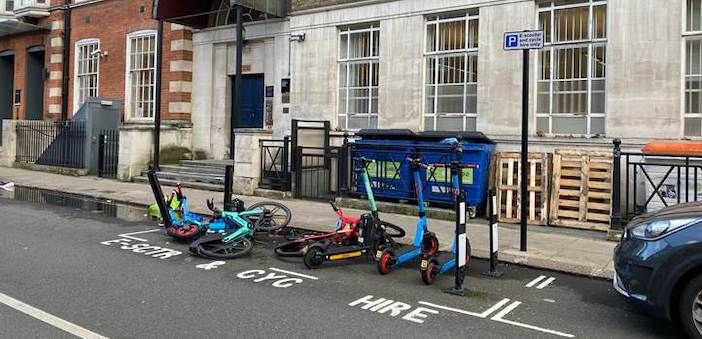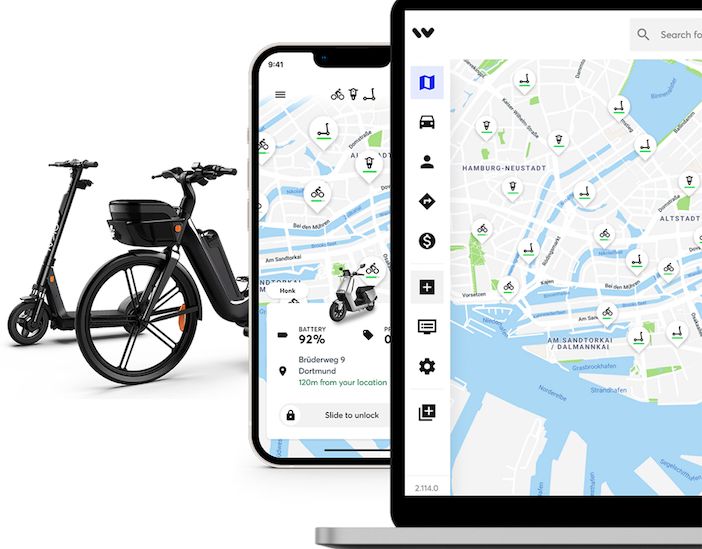Gunnar Froh, founder and CEO of Wunder Mobility, looks at the biggest reputational challenges facing an evolving sector, and offers 10 examples of how operators and authorities can address this.
Shared mobility schemes hold much promise for cities. They’ve exploded in popularity in recent years, yet a huge gulf between shared mobility and car ownership remains. Take a city like Berlin, for example. It has 1.24 million registered private cars versus approximately 50k shared mobility vehicles.
To close this gap, and as with any fast-growth sector, there are challenges to overcome. One of these is the proper use and parking of scooters, bikes and mopeds in public spaces. Ungainly sights on our streets due to improper abandonment of shared vehicles and petty vandalism, sometimes compounded by seasonal under-utilisation, are not helping public image.
For this sector to fulfil its potential, micromobility services must be viewed in high regard by citizens and policymakers alike. The conversation should be around the benefits of reducing congestion and emissions, and not undermined by the actions of a minority. Concern over care for our streets means shared scheme operators must lead on shaping user and public behaviour.
The recent news that TIER has bought an e-scooter parking assistant company and Segway’s development of a Bluetooth parking beacon show recognition of the challenge. However, not every mobility provider can acquire solutions in the same way.
So, what can be done?
Through Wunder Mobility’s knowledge of working with operators globally, here are 10 innovations that operators and authorities alike can draw inspiration from.
- Require a photo proving right parking before ending a rental
This places accountability on the rider. With shared mobility being synonymous with mobile usage it takes little effort for a user to capture such a photo. This is an easy feature to incorporate into an operator’s app, establishing a log of how vehicles have been left. Voi is an example of a major operator promoting safe e-scooter parking habits this way, but an after rental picture is a feature that can be easily introduced by all operators.

- Use in-app and billboard education for users
Through timely prompts and reminders as part of the user-experience, behaviors can be nudged. Operators should consider presenting guidance in both digital and physical formats at the points of hire and return. Overlay screens with recommended actions can support proper parking. In addition, in-app access to FAQs and the ability to trigger emails to users will also help with ongoing training.
- Implement messages on vehicles
A vehicle itself can bear instruction. For example, in an effort to reduce the number of tipped scooters blocking walkways and streets, Bird recently installed the message “Please help me up” in bright, reflective lettering on the bottom of its scooters.
- Incentivise certain actions like parking at virtually defined spots
Why should someone leave a free-floating shared vehicle in a particular place when there is no mandatory requirement to do so? Incentives including loyalty points, free rides, and other forms of discount help to drive behaviour that ensures more vehicles are left in recommended locations. As well as incentive zones, no parking zones can be implemented if certain areas are known to be problematic.
- Consider shared-mobility docking stations
In Düsseldorf, for example, a network of 100 sharing stations for docking rental scooters is being built. These partnership initiatives allow scooters from multiple providers to be docked in a common place. It shows the power of private and public collaboration to address the image problem.
Where physical docking stations are not viable, virtual stations can be created with a tight geo-fence and pin on a map.

- Create scooter parking patrol
Of course, shared vehicles can be subject to vandalism by those with no intention of using the service. Parking patrols provide presence in the community and can help rectify safety and image-related problems quickly. The City of Helsinki is in preliminary discussions with operators about launching a so-called parking patrol service. A form of parking attendant will work to move any e-scooters that have fallen or are in the wrong place.
- Notify the public about wrongly parked scooters
In a similar way, empowering the public to report on misuse builds favour with both users and non-users. Bolt has enabled its app users to report issues quickly. As well as describing the issue, users can also scan the scooter’s QR code and take a picture of the offending hardware.
As shared mobility will not be everyone’s favoured method of transportation – including elderly or disabled citizens – operators should consider how to enable them to report hazards and other issues with vehicles. This gives them a voice and builds community advocacy. It also takes pressure off services like the police who can instead prioritise crime-related matters.

- Adapt city infrastructure and rededicate car parking spaces
This approach is now commonplace in many cities. It is a very convenient way of allocating designated parking areas for shared mobility vehicles, but authorities and operators should look to combine this with other measures above.
- Give in-person safety training
Tier Mobility recently partnered with a UK-based cycling enterprise, Bikeworks to offer free e-scooter safety training in London. These training sessions are open to the public to join and are led by fully qualified instructors who cover crucial points in user safety and e-scooter use. This type of free training also builds brand advocacy and can help to encourage those who might be less confident on the road, or not very technology savvy, to try shared mobility.
- Always look for new innovations
As observed with TIER’s implementation, then acquisition, of Fantasmo’s camera positioning system, emerging technology solutions can also help. The further lesson here is that operators should choose hardware that is purpose-built for shared use.
Shared mobility is a crucial component of reducing congestion and pollution in our cities and providing people with greater choice of personal transportation. The image problem needn’t set back progress. Through a combination of simple measures, we can ensure that shared mobility adoption continues to grow safely and citizens reap the benefits.
Gunnar Froh is founder and CEO of Wunder Mobility. To learn more about shared mobility from experts in the industry, listen to the Wunder Mobility Podcast.





